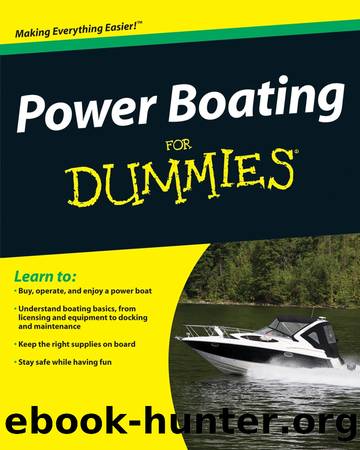Power Boating For Dummies® by Randy Vance

Author:Randy Vance
Language: eng
Format: epub
Publisher: Wiley
Published: 2010-03-08T16:00:00+00:00
Chapter 10
Finding Your Way on the Water
In This Chapter
Charting your way safely on the water
Using a tried and true navigation tool: The compass
Keeping in touch via VHF radio
Using sonar and radar for safety (and for finding fish)
Navigating with GPS gear on smaller waters
Christopher Columbus didn’t need any of the navigation devices we have today. He stumbled upon the New World with the most rudimentary tools, and I bet he would have given his right arm for a Cracker Jack spy compass and a sixth-grader’s hand-sketched world map homework project. He checked his depths (which is called taking soundings) by tossing a lead sinker on a line overboard and measuring the line when the lead hit the bottom.
Today, for less than the price of an MP3 player, you can buy more navigating power than the early astronauts had — and in a very compact package. It’s called a Global Positioning System (GPS), it costs as little as $100, and it can pinpoint your position anywhere on earth and clearly display it on an LCD screen. For another $100, you can get sonar so sophisticated you can spot big fish and tell them from the little ones before wetting a hook. More important, with GPS and sonar, you can keep your boat and crew safe from grounding and on the best route to wherever you want to go. Yet many boaters still don’t think they need this equipment, and most don’t even know how to use a basic compass.
I can’t teach you the detailed intricacies of the complex and fine art of sea navigation, but I can get you across a lake. I can tell you what tools you need for safe, simple navigation, where to get them, and how to teach yourself to use them. By the end of this chapter, I hope you’ll see the logic of getting (and knowing how to read) a compass and a chart of your waters and maybe even sonar and GPS units. I also tell you what you can expect these tools to tell you. And maybe I can even talk you into a VHF radio, so that you can tell your friends and other boaters that you absolutely do know where you are!
Charting Your Course Over Big and Little Waters
A chart of your boating waters not only helps you navigate more safely, but it can help you more easily discover cool places to take your boat. In the old days of piracy, or just good old kingdom-to-kingdom warfare, charts of unknown waters were among the most important booty. Charts are almost as valuable today.
You may expect to need a chart for traveling offshore — say, to the Bahamas — but you’ll also find inland coastal waters like the Intracoastal Waterway (ICW) difficult to navigate without a chart. (Not familiar with the ICW? Check out the sidebar, “Get to know the ICW.”) Sure, there are plenty of landmarks, but the channels twist and turn, and even if the route only veers a few degrees, that’s enough to put you deep in a sandbar if you don’t veer with it.
Download
This site does not store any files on its server. We only index and link to content provided by other sites. Please contact the content providers to delete copyright contents if any and email us, we'll remove relevant links or contents immediately.
Breath by James Nestor;(2131)
The River by Peter Heller(2084)
Fatal Storm by Rob Mundle(2056)
Deep by James Nestor(2054)
Sea Survival Handbook by Keith Colwell(2027)
Lonely Planet Australia by Lonely Planet(1949)
Iced In by Chris Turney(1823)
Discover Australia by Lonely Planet(1822)
Lonely Planet Maldives (Travel Guide) by Planet Lonely & Masters Tom(1705)
One Girl One Dream by Dekker Laura(1563)
Looking for a Ship by John McPhee(1556)
Ten Degrees of Reckoning: The True Story of a Family's Love and the Will to Survive by Hester Rumberg(1533)
Chicken Soup for the Ocean Lover's Soul by Jack Canfield(1520)
Lonely Planet Australia (Travel Guide) by Lonely Planet & Lonely Planet(1496)
South with the Sun by Lynne Cox(1441)
The Wave In Pursuit of the Rogues, Freaks and Giants of the Ocean(1410)
Marlinspike Sailor's Arts and Crafts by Barbara Merry(1400)
Diver Down by Michael Ange(1400)
The Golden Rules: 10 Steps to World-Class Excellence in Your Life and Work by Bob Bowman & Charles Butler(1369)
